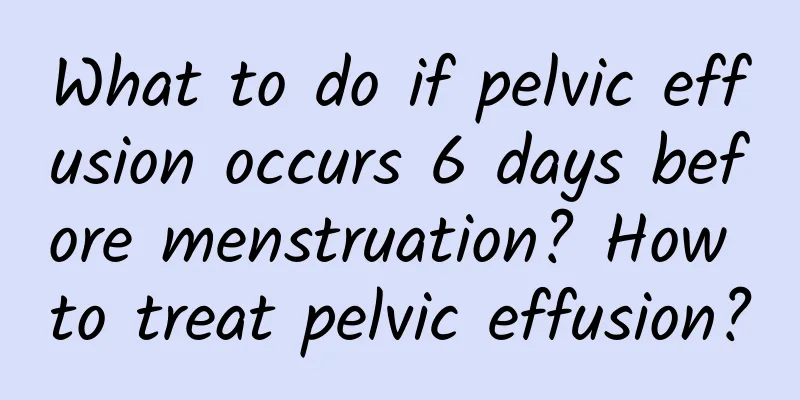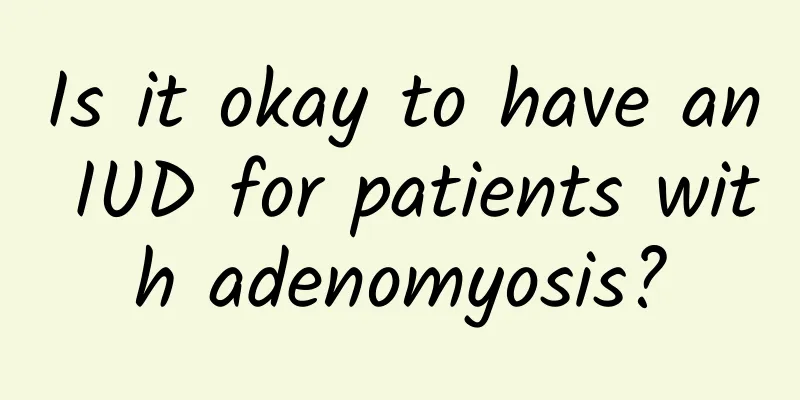What to do if pelvic effusion occurs 6 days before menstruation? How to treat pelvic effusion?

|
Nowadays, many female friends suffer from some troublesome gynecological diseases, pelvic effusion is one of them, which makes many women headache. So, what should we do if pelvic effusion occurs 6 days before menstruation? How to treat pelvic effusion? During menstruation or ovulation, a small amount of blood will accumulate in the pelvic cavity, forming pelvic effusion, which is physiological pelvic effusion. Normal pelvic effusion is 10mm, and it is abnormal if it exceeds the above range. Therefore, it is recommended that female friends who find that they are unwell and have obvious symptoms of pelvic effusion can choose to go to the hospital for a detailed examination. The following are actual treatment methods for pelvic effusion. Patients in need can choose the treatment method that suits them according to their condition. 1. General treatment: increase nutrition, arrange work and rest time reasonably, do physical exercise, improve body resistance, pay attention to the combination of work and rest, maintain a cheerful mood, and enhance confidence in treatment. 2. Surgical treatment: When the lesion is found to require surgical treatment, it should be treated with surgery. The principle of surgery is to completely cure the lesion and avoid the chance of recurrence of the remaining lesions. Unilateral adnexectomy or hysterectomy plus bilateral adnexectomy should be performed. The effect of single therapy for chronic pelvic inflammatory disease is poor, and comprehensive treatment is appropriate. The implementation of surgical treatment is more suitable for cases with lumps, such as hydrosalpinx and tubo-ovarian cysts. If there are small infection foci that repeatedly cause inflammatory attacks, surgical treatment is also appropriate. 3. Physical therapy: Benign warm stimulation can promote local blood circulation in the pelvic cavity, improve the nutritional status of tissues, enhance metabolism, and facilitate the absorption and disappearance of inflammation. 4. Drug treatment: Targeted drug treatment can be carried out according to the different causes of the disease. For example, when inflammation occurs, anti-inflammatory drugs can be used to facilitate the absorption of adhesion and inflammation. If individual patients have local or systemic allergic reactions, the drug should be discontinued. |
<<: Can coarse salt be used for hot compresses in pelvic effusion?
>>: How to treat amenorrhea caused by premature ovarian failure
Recommend
How does traditional Chinese medicine treat cervical erosion? Introduction to Western medicine treatment methods for female cervical erosion
There are generally three types of cervical erosi...
What are the clinical manifestations of pelvic peritonitis?
Pelvic peritonitis is a very common gynecological...
Lower back pain, frequent falls when walking…lack of hip muscle strength! 3-minute hip exercise for healthy slimming
Do you have such a situation? Even when walking o...
Vulvar leukoplakia is unbearable. What should we do? Experts tell you!
Medically, the whitening, roughening, and shrinki...
How to avoid gynecological diseases after abortion
After an abortion, the patient will be weak and h...
Low-calorie tonic for the winter solstice! All-vegetarian hotpot is good for your spleen and stomach
December 22 is the "Winter Solstice" in...
Poor sleep can lead to obesity! 3 nutrients to secrete leptin
Not only will eating too much and not exercising ...
Be careful not to damage your kidneys if you buy any diet pills casually! Learn all about weight loss drugs at once: oral tablets, injection pens
With the change of lifestyle and the prevalence o...
Are the symptoms of uterine fibroids obvious? Can uterine fibroids cause menstrual abnormalities?
In today's society, there are more and more d...
Repeated high-temperature bathing can relieve stress and burn calories in one go
Sweating a lot not only makes your skin more beau...
What are the common causes of cervical precancerous lesions?
There are many reasons for cervical precancerous ...
Get rid of the New Year weight! 3 ways to lose weight and shape your body with towels
Did you move too little and eat too much during t...
What is the cause of habitual miscarriage? Pay attention to these 7 problems
There are many reasons for habitual miscarriage, ...
What auxiliary examinations are needed for women with amenorrhea
Amenorrhea is a gynecological disease that many w...
Butchers evade investigation! New Taipei City investigates and sends first case to the government
The New Taipei City Government's Health Burea...









